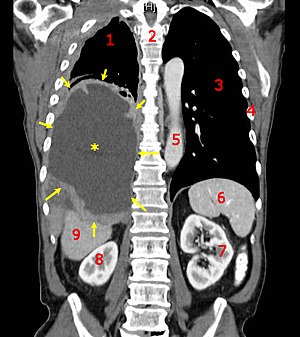Surgery, either by itself or used in combination with pre- and post-operative adjuvant therapies, has proved disappointing. A pleurectomy/decortication is the most common surgery, in which the lining of the chest is removed. Less common is an extrapleural pneumonectomy (EPP), in which the lung, lining of the inside of the chest, the hemi-diaphragm and the pericardium are removed. It is not possible to remove the entire mesothelium without killing the patient.
Mesothelioma is fairly rare. There are an estimated 2,000 to 3,000 new cases of mesothelioma each year in the United States. The incidence of mesotheliomas in the United States increased from 1970 to 1990 and then stabilized. It may now be decreasing. Most of the past increase in cases, as well as the recent decrease in cases, has been in men. The rate, although lower, has been fairly steady for women. In European countries and world wide, the rate of mesotheliomas is still increasing.
Mesothelioma is rare in people under age 55. Its incidence increases with age. Three-fourths of people with mesothelioma are over 65 years old. The disease affects men 5 times more often than women. Mesothelioma is less common in African Americans than in white Americans.
Mesothelioma is a serious disease. The only known cause of mesothelioma is asbestos. By the time the symptoms appear and cancer is diagnosed, the disease is often advanced. The average survival time is about 1 year. The 5-year relative survival rate is around 10%, but this rate has been slowly improving.
The 5-year survival rate refers to the percentage of patients who live at least 5 years after their cancer is diagnosed. Many of these patients live much longer than 5 years after diagnosis, and 5-year rates are used to produce a standard way of discussing prognosis. Five-year relative survival rates do not include patients dying of other diseases and are considered to be a more accurate way to describe the prognosis for patients with a particular type and stage of cancer. That means that relative survival only talks about deaths from mesothelioma. Of course, 5-year survival rates are based on patients diagnosed and initially treated more than 5 years ago. They may no longer be accurate. Improvements in treatment result in a more favorable outlook for recently diagnosed patients.
- Each year 2,500 to 4,000 patients in the
U.S. - Mesothelioma has a long latency (inactive) period of anywhere between 15 – 50 years.
- Experts predict that mesothelioma diagnoses will continue to increase in the
United States - While many countries have banned certain forms of asbestos, an estimated 5,000 asbestos-containing products exist today.
- As many as 8 million people in the U.S. have already been exposed to asbestos and it continues to pose a serious threat to workers in certain occupations.
- One study of asbestos insulation workers reported a mesothelioma death rate up to 344 times higher than the general population.
- Most mesothelioma victims die within 18 months of diagnosis. Mortality is swift not because the cancer is fast-growing but because it usually is far advanced by the time it is detected.
- Poor prognostic variables include: nonepithelial histology, older age (greater than 75 years), pleural primary, chest pain at presentation, poor performance status, and elevated platelet count (greater than 400,000/mcL).
- By the year 2030 there are estimates that asbestos will have caused 60,000 instances of mesothelioma and around 250,000 other cancers that result in death.
- Over half a million asbestos and mesothelioma injury claims have been filed to date. Over 50,000 were filed in 1998 alone.
- Every year, more than 10,000 people worldwide (3,000 in the U.S. alone) are diagnosed with mesothelioma or other asbestos-related conditions.
- More than 110,000 schools in the U.S. still contain some form of asbestos.
- 8 million Americans have been exposed to dangerous levels of asbestos.
- Asbestos insulation workers have a mesothelioma death rate 344 times higher than that of the general population.
- More than 7,500 Americans died from mesothelioma between 1999 and 2001.
- The industries with the highest mesothelioma mortality rates are ship building and ship repairing.
- People working around industrial chemicals had the second-highest rate, and those in the construction industry were third.
- 85% of mesothelioma deaths are male; this has more to do with asbestos exposure than with gender.
- There is also a high rate of mesothelioma deaths among schoolteachers, many of whom are female.
- The average age of people diagnosed with mesothelioma is between 50 and 70, but the number of people diagnosed with mesothelioma between the ages of 30 and 40 is increasing.
- Asbestos is used to make more than 5,000 products worldwide.
- Even when mesothelioma treatment is possible, it is very expensive, sometimes costing between $400,000 and $800,000 for oxygen, drugs, pain medicine and other forms of treatment









